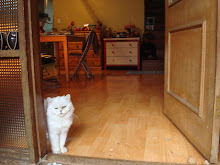Besides the official
Seoul Central Mosque in Itaewon (my post here) , the list of mosques in other provinces in Korea is below, this list doesn't include the mosques (masjid)/prayers rooms that students or other private individuals have established:
Gyeonggi-do/ Paju Masjid
Located near the Imjin River , the Paju Masjid is mostly frequented by Bangladeshi and Pakistani Muslims in the vicinity.
Address : 421-9, Yeongtae-ri, Wonreung-myeon, Paju-si, Gyeonggi-do
Tel : +82-31-946-2110
Bupyeong Masjid
Located in the east end of Incheon, Bupyeong Masjid is a place of worship for immigrant Muslim workers in nearby areas, including Namdong Industrial Complex in Incheon.
Address : 574-19, Sipjeong-dong, Bupyeong-gu, Incheon
Tel : +82-32-512-2612
Anyang Masjid
Anyang Masjid, not far from Seoul, is operated independently by Muslim immigrants from Bangladesh and Pakistan.
Address : 618-132, Anyang 5-dong, Anyang-si, Gyeonggi-do
Tel : +82-31-444-7757
Ansan Masjid
An imam from Bangladesh serves at the Ansan Masjid, which is operated independently by immigrant Muslims from Bangladesh, Pakistan, and Indonesia working at the nearby Ansan Industrial Complex.
Address : 741-5, Wongok-dong, Danwon-gu, Ansan-si, Gyeonggi-do
Tel : +82-31-492-1948
Gwangju Masjid
In Gwangju (Gyeonggi-do), which is adjacent to Seongnam, Icheon and Namyangju, Gwangju Masjid, Korea 's third masjid, was opened in 1981.
Address : 48-9, Yeok-ri, Gwangju-eup, Gwangju-gun, Gyeonggi-do
Tel : +82- 31- 761-3424
Jeolla-do/Jeonju Masjid
Matching Jeonju's reputation as a city of tradition and art, Jeonju Masjid shows the harmony between Korean and Islamic architecture. Traditional Korean roof tiles adorn the Islamic dome.
Address : 1562-10, Inhu-dong 2-ga, Deokjin-gu, Jeonju-si, Jeollabuk-do
Tel : +82- 63- 243-1483
Busan/Busan Masjid
Busan Masjid was the second masjid to open in Korea. It was built in 1980 with financial support from Ali Fellaq, the former minister of finance of Libya .
Address : 30-1, Namsan-dong, Geumjeong-gu, Busan
Tel : +82- 51- 518-9991
Islamic Centers/Macheon-Geoyeo Center
Address : 186-26, Geoyeo-dong, Songpo-gu, Seoul
Tel : +82-2- 431-6850
Suwon Center
Address : 320-15, Dangsu-dong, Gwonseon-gu, Suwon , Gyeonggi-do
Tel : +82- 31- 295-2956
Jeju Center
Address : Rm. 1215, Jeonghan Officetel, 939, Nohyeong-dong, Jeju
Tel : +82- 64- 712-1215
Daegu Center
Address : 202-6, Jukjeon-dong, Dalseo-gu, Daegu
Tel : +82-53- 523-2171
Gwangju Center
Address : 894-7, Wolgyeo-dong, Gwangsan-gu, Gwangju
Tel : +82-62- 972-5136
Website of Korea Muslim Foundation: http://www.koreaislam.org (Korean, English)
For Pocheon, Cheonnan, Kimhae and Jinju please look
at the this blog post by an Indonesian blogger.
OR
Visit Korea Muslim Federation website, here they have
updated a list of mosques in various cities but it is in Korean language however, one can get help to locate phone number and address.
Credits: Korea Tourism Corporation







































































 sarahinsouthkorea
sarahinsouthkorea
